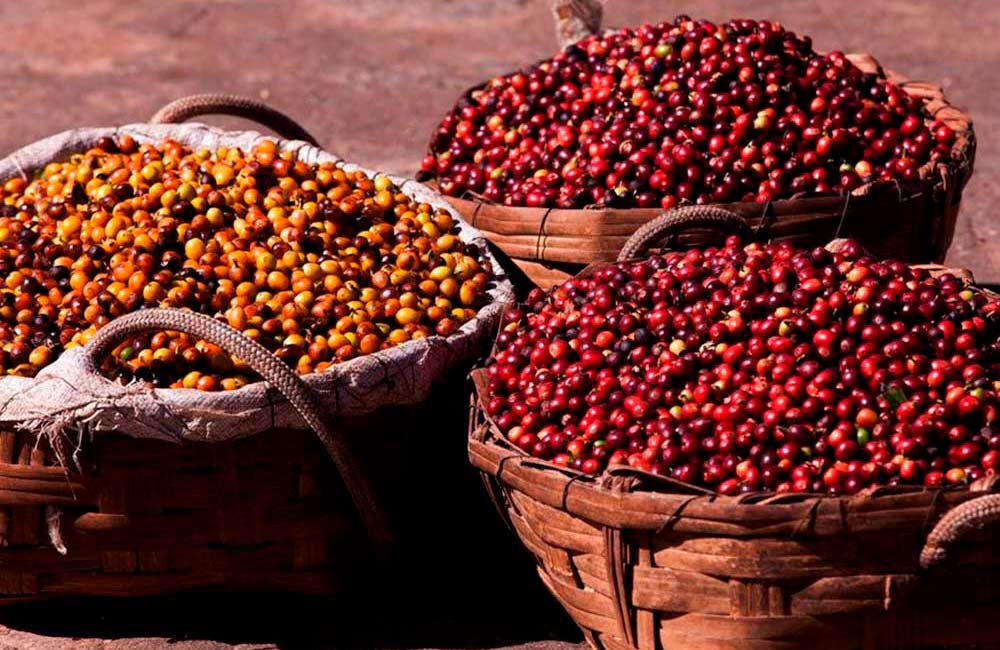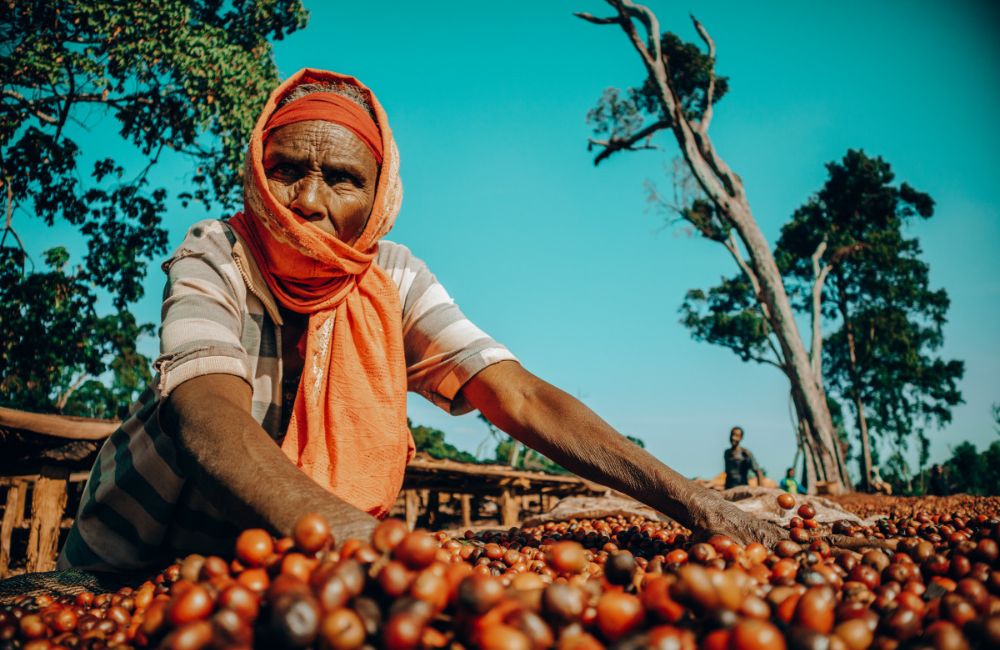Brasil: El alma del café de especialidad
Brasil es un gigante cafetero que ha moldeado su cultura, economía y paisaje a través del café. Este país no solo lidera en volumen de producción, sino que también se ha convertido en un referente en calidad, diversidad e innovación en el café de especialidad. Desde sus vastas regiones productoras hasta las técnicas avanzadas de cultivo, Brasil ofrece una experiencia única en cada taza.
En este artículo, exploramos la historia, las regiones, los métodos de cultivo, la temporada de cosecha y cómo disfrutar al máximo de los cafés brasileños.
1. Historia del café en Brasil

El café de Brasil tiene una larga y arraigada historia
Brasil, el mayor productor de café del mundo, tiene una historia fascinante que refleja cómo este cultivo ha moldeado su economía y cultura. Desde su llegada en el siglo XVIII hasta su posición actual como referente en café de especialidad, el viaje del café brasileño está lleno de momentos clave.
La llegada del café a Brasil
El café llegó a Brasil en 1727 gracias a Francisco de Melo Palheta, un oficial portugués-brasileño que obtuvo las primeras semillas en un curioso incidente diplomático. Durante un conflicto territorial entre Francia y los Países Bajos, Palheta viajó a la Guayana Francesa, donde, según la historia, Madame D’Orvilliers, esposa del gobernador de Cayena, le entregó semillas de café escondidas en un ramo de flores. Estas semillas fueron plantadas en el estado de Pará, marcando el inicio de una nueva era para Brasil.
Inicialmente, el café se cultivaba solo para consumo local, pero la creciente demanda en América y Europa durante el siglo XIX impulsó su expansión. Para 1770, las plantaciones ya habían alcanzado Río de Janeiro, y en 1830 el café se convirtió en el principal producto de exportación del país, consolidando su posición en el mercado internacional.
El desarrollo de la industria cafetera en Brasil
A lo largo de los siglos, la industria cafetera brasileña ha pasado por diversas etapas que han definido su trayectoria:
1. Los comienzos y expansión (1727-1820):
Tras su primera plantación en Pará, el cultivo del café se extendió hacia el sur, alcanzando Río de Janeiro en 1770.Durante este período, el café se cultivaba principalmente para consumo interno, pero la demanda externa en el siglo XIX impulsó la expansión de las plantaciones.
2. El auge de las exportaciones (1820-1888):
Entre 1820 y 1888, Brasil comenzó a producir el 20% del café mundial. Río de Janeiro, São Paulo y Minas Gerais lideraron esta producción.En 1830, el café se consolidó como el principal producto de exportación brasileño.Durante este período, la industria dependió en gran medida del trabajo esclavo, hasta la abolición de la esclavitud en 1888, lo que llevó a cambios significativos en la mano de obra.
3. Estabilización y expansión (1888-1945):
A principios del siglo XX, Brasil implementó programas de estabilización de precios, como el Acuerdo de Taubaté en 1906, para proteger a los caficultores frente a las fluctuaciones del mercado.
Durante la Primera Guerra Mundial, se iniciaron acuerdos internacionales para estabilizar los precios del café, lo que ayudó a Brasil a mantener su liderazgo.
4. Mejora de la calidad y diversificación (1990-presente):
Desde la década de 1990, Brasil ha dado un giro hacia la calidad. Se estableció la Brazil Specialty Coffee Association (BSCA), y competiciones como la "Cup of Excellence" han elevado el perfil del café brasileño de especialidad.Regiones como Piata, Carmo de Minas, y Vale da Grama se han convertido en sinónimo de calidad, produciendo cafés galardonados a nivel internacional.
El legado actual
El café de especialidad en Brasil es el resultado de siglos de innovación y dedicación. Desde sus humildes comienzos hasta su transformación en un producto de exportación de alta calidad, el café brasileño no solo representa un pilar económico, sino también un emblema cultural que conecta al país con el resto del mundo. Hoy, cada taza de café de especialidad de Brasil cuenta una historia de tradición, esfuerzo e innovación que continúa evolucionando.
2. Regiones cafeteras en Brasil

Principales zonas de cultivo de café en Brasil
Brasil cuenta con una amplia variedad de regiones cafetaleras, cada una con características geográficas y climáticas únicas que influyen en el perfil y la calidad del café producido. Desde altitudes elevadas hasta climas tropicales, el país ofrece condiciones ideales para el cultivo de café tanto de Coffea arabica como de robusta.
Principales regiones cafetaleras de Brasil
1. Minas Gerais
Ubicación: Situada en el sureste de Brasil, es la región cafetera más grande del país.
Subregiones destacadas:
- Sul de Minas: Reconocida por sus cafés con cuerpo completo, acidez balanceada y notas de chocolate y caramelo.
- Cerrado Mineiro: La primera región en Brasil con denominación de origen, famosa por sus cafés de alta calidad con perfiles dulces y consistentes.
Altitud y clima: Elevaciones entre 800 y 1,300 msnm con un clima templado que favorece un crecimiento uniforme.
2. São Paulo
Ubicación: Al sur de Minas Gerais, destaca especialmente la región de Mogiana.Características: Cafés suaves con notas de chocolate, almendras y frutos secos, gracias a un clima moderado y altitudes entre 800 y 1,200 msnm.Importancia: Una de las regiones históricas para la producción de café, clave durante el auge del siglo XIX.
3. Espírito Santo
Ubicación: Al noreste de Minas Gerais.Producción: Reconocida por su cultivo de robusta (conilon) y arábica, adaptándose a un clima tropical húmedo y altitudes de 400 a 1,000 msnm.Perfil: Cafés con notas fuertes y terrosas, ideales para mezclas.
4. Bahía
Ubicación: En el noreste de Brasil, con especial énfasis en la subregión de Chapada Diamantina.Características: Un clima tropical seco y semiárido combinado con altitudes entre 800 y 1,200 msnm.Perfil: Cafés complejos y exóticos con acidez brillante y notas cítricas.
5. Paraná
Ubicación: En el sur de Brasil, es una región menos extensa pero significativa para el arábica de calidad.Altitud y clima: Elevaciones de 700 a 1,000 msnm con un clima subtropical fresco que contribuye a un crecimiento lento y perfiles balanceados.
Impacto de las condiciones naturales en la calidad del café
Altitud
Las regiones más elevadas, por encima de los 1,000 msnm, son ideales para producir granos de alta calidad. A estas altitudes, los cafetos crecen más lentamente, lo que permite desarrollar granos densos y complejos en sabor.En Brasil, muchas regiones como Minas Gerais y Bahía alcanzan altitudes óptimas para el cultivo de arábica.
Clima
Climas moderados con estaciones secas prolongadas, como en Minas Gerais y São Paulo, ayudan a controlar plagas y crear condiciones ideales para la cosecha.Los climas tropicales húmedos, como el de Espírito Santo, promueven un crecimiento vigoroso y perfiles más ricos en robusta.
Topografía
Las combinaciones de colinas y llanuras en regiones como Cerrado Mineiro crean microclimas únicos, favoreciendo el desarrollo de distintos tipos de café.El terreno montañoso de Sul de Minas proporciona un buen drenaje, lo que contribuye a cafés con perfiles limpios y bien estructurados.
3. Tipos de Café de Brasil: Principales Variedades

Cerezas de café en proceso de maduración
Brasil es un país conocido por la diversidad de variedades de café que cultiva, con un enfoque predominante en la Coffea arabica y una producción significativa de robusta (conilon). Estas variedades reflejan la riqueza de sus regiones cafetaleras y las prácticas agrícolas innovadoras empleadas por sus productores.
1. Arabica: La estrella del café brasileño
Brasil es uno de los mayores productores de arábica en el mundo, y cultiva varias variedades con características únicas:
Bourbon
- Características: Una de las variedades más antiguas de arábica, conocida por sus variantes rojas (Bourbon Vermelho) y amarillas (Bourbon Amarelo). Los granos son más redondos que otras variedades como la Typica.
- Condiciones de cultivo: Se adapta bien a altitudes entre 1,000 y 2,000 msnm, con alta humedad y precipitaciones constantes durante todo el año.
- Perfil de sabor: Dulzura natural y suavidad, con notas de frutas y flores, acidez sutil y un retrogusto prolongado. Incluye sabores como caramelo, miel, bayas y cítricos.
Mundo Novo
- Características: Un híbrido entre Typica y Bourbon, descubierto en Brasil en los años 40. Representa aproximadamente el 40% de la producción de café arábica en el país.
- Perfil de sabor: Dulce, con cuerpo completo, notas de chocolate, almendra y avellana, y baja acidez. Retrogusto suave y prolongado.
Catuai
- Características: Un cruce entre Mundo Novo y Caturra, resistente al clima y de alto rendimiento. Disponible en variedades roja y amarilla.
- Perfil de sabor: Dulzura natural similar a la miel, con sabores frescos y ricos como bayas, manzanas y cítricos. Acidez media equilibrada con la dulzura.
Caturra
- Características: Una mutación natural del Bourbon, con tamaño más compacto y mayor rendimiento.
- Perfil de sabor: Notas de frutas como naranja, manzana y bayas, con acidez brillante y dulzura similar al azúcar moreno o la miel.
2. Robusta (Conilon): Fuerza y resistencia
Aunque el foco principal de Brasil es el arábica, el robusta constituye entre el 20% y el 30% de la producción total de café del país, destacándose en regiones como Espírito Santo y Rondônia.
Características del robusta
- Granos más pequeños, redondos y uniformes.
- Resistentes a plagas y enfermedades, ideales para climas cálidos y altitudes bajas (400-1,000 msnm).
- Espírito Santo lidera la producción, con un 80% de la producción nacional de robusta.
Perfil de sabor
- Sabor fuerte y amargo, con menor acidez que el arábica.
- Notas predominantes de madera, tierra y anacardo, con un toque ahumado o quemado.
- Cuerpo denso y textura pesada, ideal para mezclas que buscan fuerza.
3. Comparación entre arábica y robusta en Brasil
| Característica | Arábica | Robusta |
|---|---|---|
| Altitud de cultivo | 800-2,000 msnm | 400-1,000 msnm |
| Clima | Tropical/subtropical, templado | Tropical húmedo |
| Perfil de sabor | Dulzura, acidez balanceada, floral | Amargo, cuerpo pesado, terroso |
| Uso principal | Cafés de especialidad | Mezclas y cafés instantáneos |
La diversidad de variedades de café en Brasil permite atender una amplia gama de preferencias y mercados. Mientras que el arábica lidera la producción de café de especialidad, el robusta satisface la alta demanda de café en mezclas y usos industriales. Esta combinación hace de Brasil un gigante capaz de adaptarse a las tendencias globales sin perder su identidad única en la industria.
4. Métodos de cultivo y procesamiento del café en Brasil

Proceso del café en Brasil
Brasil no solo se beneficia de sus condiciones naturales ideales para el cultivo del café, sino también del arduo trabajo de sus agricultores y productores. Estos combinan técnicas innovadoras y prácticas tradicionales para crear lotes de café excepcionales que destacan en el mercado internacional.
Cultivo del café en Brasil
La calidad y cantidad del café brasileño son el resultado de un complejo proceso de cultivo que incluye varios pasos esenciales:
-
Selección de variedades:
- Regiones situadas entre 800 y 2,000 msnm, como Minas Gerais, São Paulo y Bahía, son ideales para el desarrollo del arábica.
- En altitudes más bajas (0-800 msnm), como Espírito Santo y Rondônia, predomina el cultivo de robusta debido a las condiciones climáticas cálidas.
-
Preparación del suelo:
Los suelos se preparan cuidadosamente, labrándolos y enriqueciendo su fertilidad con fertilizantes orgánicos para ajustar los niveles de pH y promover un crecimiento saludable de los cafetos.
-
Riego:
Se aplican técnicas de riego por goteo y aspersión para garantizar que los cafetos reciban suficiente agua, especialmente en etapas cruciales como la floración y la fructificación.
-
Nutrición de las plantas:
Los agricultores combinan fertilizantes orgánicos y químicos, ajustándolos en función de análisis del suelo y las necesidades nutricionales de los cafetos en cada etapa de su crecimiento.
-
Control de plagas y enfermedades:
Las malas hierbas se controlan mecánica y químicamente, mientras que los productores seleccionan variedades de café resistentes a enfermedades para minimizar el impacto en los cultivos.
Recolección del café en Brasil
La recolección del café en Brasil suele comenzar en mayo y se extiende hasta septiembre, dependiendo del área de cultivo, las condiciones climáticas y la variedad de café. Existen dos métodos principales de recolección:
-
Recolección manual:
Este método, aunque laborioso y lento, implica recoger a mano las cerezas maduras y clasificarlas cuidadosamente. Es preferido en regiones montañosas y en fincas enfocadas en la calidad debido a su precisión en la selección.
-
Recolección mecánica:
Utiliza máquinas equipadas con sensores para identificar cerezas maduras y recolectarlas automáticamente. Aunque ahorra tiempo y mano de obra, requiere una inversión inicial significativa en maquinaria moderna.
El método de recolección depende de factores como la topografía, las condiciones de la finca y los objetivos de calidad del productor.
Procesamiento del café brasileño
El procesamiento del café es crucial para desarrollar los perfiles de sabor. En Brasil, se emplean varios métodos dependiendo de la región, las condiciones climáticas y las preferencias del productor:
-
Procesamiento en seco (natural):
Las cerezas se limpian y se extienden en patios para secarse al sol, permitiendo que los granos absorban los compuestos del mucílago. Este proceso crea cafés dulces, complejos y suaves. Aunque es un método lento (requiere 25-30 días), Brasil ha implementado sistemas de secado modernos para evitar la sobrefermentación.
-
Procesamiento en húmedo:
Este método elimina cuatro capas alrededor del grano, lo que resulta en cafés más limpios, brillantes y aromáticos. Incluye etapas de clasificación, lavado, despulpado, fermentación y secado. Aunque menos común que el método natural, ofrece perfiles distintivos.
-
Procesamiento semi-húmedo (pulped natural):
Combina características de los métodos seco y húmedo. Los granos conservan parte del mucílago, lo que aporta dulzura mientras mantiene cierta acidez. Es popular en áreas de baja humedad y ha hecho famoso a Brasil en el mundo del café de especialidad.
Innovaciones en la producción de café en Brasil
Con los avances tecnológicos y una mayor conciencia sobre la sostenibilidad, la producción de café en Brasil se ha vuelto más eficiente y progresiva:
- Gestión de cultivos: Uso de sensores y análisis de datos para monitorear las condiciones del suelo, el agua y la nutrición de las plantas.
- Predicción meteorológica: Análisis de datos climáticos para predecir cosechas y gestionar riesgos.
- Sistemas de riego automatizados: Técnicas de goteo y aspersión controladas automáticamente según las necesidades de las plantas.
- Maquinaria moderna: Equipos avanzados para la recolección y procesamiento, que ahorran tiempo y garantizan consistencia en los resultados.
- Fertilizantes orgánicos: Mayor uso de fertilizantes naturales para mejorar la salud del suelo y reducir el impacto ambiental.
- Agricultura regenerativa: Técnicas que conservan la biodiversidad y mejoran la calidad del suelo a largo plazo.
5. Principales características del café de especialidad de Brasil en función de la región

Proceso del café en Brasil
Brasil cuenta con diversas regiones cafetaleras que no solo se destacan por sus condiciones climáticas y geográficas, sino también por los perfiles únicos de sabor que aportan a los granos cultivados. Cada una de estas regiones tiene características distintivas que las hacen imprescindibles en el mundo del café de especialidad.
Minas Gerais
- Descripción: Es la región cafetera más grande de Brasil, famosa por la producción de granos de arábica de alta calidad.
-
Características distintivas:
- Sabor: Rico y complejo, con notas florales, toques de bayas y matices a nueces.
- Acidez: Suave y equilibrada, aportando frescura al perfil.
- Estructura: Cuerpo medio a completo, con dulzura natural y un retrogusto suave.
São Paulo
- Descripción: Hogar de áreas icónicas como Mogiana y Garça, esta región es una de las más reconocidas de Brasil.
-
Características distintivas:
- Sabor: Dulce, con notas de chocolate, frutos secos y frutas deshidratadas.
- Acidez: Media, que aporta redondez y un sabor agradable.
- Estructura: Cuerpo medio a completo, con un retrogusto suave y persistente.
Bahía
- Descripción: Con un enfoque especial en la subregión de Chapada Diamantina, Bahía es una región emergente en el café de especialidad.
-
Características distintivas:
- Sabor: Notas de frutas tropicales, nueces y flores.
- Acidez: Brillante, fresca y prominente, creando una complejidad única.
- Estructura: Cuerpo ligero a medio, con un retrogusto dulce y agradable.
Espírito Santo
- Descripción: Una región diversa que produce tanto arábica como robusta de alta calidad.
-
Características distintivas:
- Sabor: Intenso, con notas de chocolate oscuro, especias y matices terrosos.
- Acidez: Baja, aportando un sabor rico y suave.
- Estructura: Cuerpo completo, con un retrogusto largo e intenso.
6. Temporada de cosecha del café brasileño
La temporada de cosecha del café en Brasil varía según la región, las condiciones climáticas y las altitudes. Gracias a la diversidad geográfica del país, la cosecha se extiende desde abril hasta septiembre, asegurando un suministro constante de café fresco.
Calendario de cosecha por región
- Regiones de baja altitud (Espírito Santo, Rondônia): De abril a junio. Estas áreas, ideales para robusta y arábica de menor altitud, comienzan la cosecha antes debido a su clima cálido.
- Regiones de altitud media (São Paulo, Cerrado Mineiro): De mayo a agosto. Las altitudes moderadas y el clima templado permiten una maduración uniforme de las cerezas.
- Regiones de alta altitud (Sul de Minas, Bahía): De junio a septiembre. Las condiciones más frescas retrasan la maduración, ofreciendo cerezas de alta calidad con perfiles complejos.
Factores que influyen en la cosecha
La temporada de cosecha depende de varios factores, que incluyen:
- Altitud: Las zonas más altas experimentan maduración más lenta, lo que da como resultado granos más densos y complejos.
- Clima: La ausencia de lluvias durante la temporada de cosecha es crucial para evitar fermentaciones no deseadas durante el secado.
- Variedades de café: Algunas variedades, como Bourbon o Catuai, tienen tiempos de maduración más uniformes, facilitando una cosecha más eficiente.
7. Caficultores brasileños y su labor

Caficultores brasileños
El éxito del café de especialidad brasileño no sería posible sin el esfuerzo y la dedicación de sus caficultores, así como el apoyo de asociaciones que promueven la calidad, sostenibilidad y comercio justo en la industria. A continuación, destacamos algunos de los principales actores en este sector:
Cultivadores destacados
-
Fazenda São Silvestre (Cerrado Mineiro): Reconocida por su innovación en procesos como la fermentación carbónica, esta finca produce lotes excepcionales que combinan dulzura, cuerpo y complejidad.
-
Pé de Cedro (Minas Gerais): Especializada en la variedad Red Bourbon, esta finca es conocida por su enfoque artesanal y sostenible, ofreciendo cafés con cuerpo cremoso y notas de caramelo.
-
Fazenda Vila Boa (Bahía): Con un enfoque en métodos de procesamiento natural y honey, esta finca produce cafés intensos y aromáticos, caracterizados por su perfil dulce y exótico.
-
Pequeños productores en Espírito Santo: Aunque menos conocidos, los agricultores de esta región están ganando reconocimiento por sus robustas de alta calidad y arábicas con perfiles únicos.
Asociaciones de café en Brasil
Las asociaciones desempeñan un papel fundamental en la promoción y el desarrollo del café de especialidad en Brasil, ayudando a conectar a los productores con el mercado internacional y fomentando prácticas sostenibles.
-
Brazil Specialty Coffee Association (BSCA): Fundada en 1991, esta organización promueve la calidad del café brasileño en el mercado global, certifica lotes de alta calidad y organiza eventos como la Cup of Excellence.
-
Associação dos Cafeicultores do Cerrado: Representa a los productores del Cerrado Mineiro, garantizando estándares de calidad y trazabilidad mediante la Denominación de Origen (DO) de la región.
-
Cooperativas regionales: Cooperativas como Cooxupé (Minas Gerais) y Cooabriel (Espírito Santo) apoyan a pequeños productores, promoviendo el comercio justo y la sostenibilidad.
El impacto de los productores y asociaciones
Gracias al esfuerzo conjunto de los caficultores y las asociaciones, Brasil ha logrado posicionarse como un líder en café de especialidad. Estos actores no solo elevan los estándares de calidad, sino que también garantizan prácticas sostenibles y un impacto positivo en las comunidades cafeteras.
Cómo disfrutar y comprar café de especialidad de Brasil
El café de especialidad de Brasil ofrece una experiencia única que combina tradición, innovación y los sabores distintivos de cada región. Para sacar el máximo partido de estos cafés excepcionales, es importante considerar los métodos de preparación adecuados y los maridajes que realzan sus cualidades. Además, al comprar café de especialidad de Brasil, asegúrate de elegir opciones de alta calidad que reflejen el compromiso de sus productores.
Métodos de preparación recomendados
Los métodos de preparación pueden resaltar diferentes aspectos del café brasileño:
- V60 o Chemex: Ideales para cafés con perfiles complejos y notas frutales, como los de Minas Gerais o Bahía. Estos métodos resaltan la dulzura y la acidez equilibrada.
- Prensa francesa: Perfecta para cafés con cuerpo completo y matices a chocolate y nueces, típicos de São Paulo y Espírito Santo.
- Espresso: Una elección excelente para cafés de cuerpo intenso, como los procesados naturalmente en Espírito Santo, que destacan por su textura cremosa y su sabor profundo.
Maridajes ideales para el café brasileño
El café de Brasil combina de forma extraordinaria con una variedad de alimentos, elevando la experiencia sensorial:
- Chocolate negro: Resalta las notas a nueces y cacao presentes en los cafés de São Paulo y Espírito Santo.
- Frutas tropicales: Complementan la acidez brillante y los sabores exóticos de los cafés de Bahía.
- Postres con nueces: Realzan la dulzura natural y el cuerpo sedoso de los cafés de Minas Gerais.
Consejos para comprar café de especialidad de Brasil
Si buscas disfrutar de los mejores cafés de Brasil, aquí tienes algunos consejos prácticos para realizar una compra informada:
- Busca sellos de calidad: Opta por cafés con certificaciones como las otorgadas por la Brazil Specialty Coffee Association (BSCA) o reconocimientos en competiciones como la Cup of Excellence.
- Compra fresco: Asegúrate de elegir café recién tostado para disfrutar al máximo de sus aromas y sabores. Evita el café molido si puedes molerlo en casa.
- Conoce la región: Escoge cafés específicos de regiones como Minas Gerais, São Paulo o Bahía para explorar diferentes perfiles de sabor.
- Apoya la sostenibilidad: Busca tostadores que trabajen directamente con pequeños productores brasileños, garantizando prácticas sostenibles y comercio justo.
En nuestra tienda, encontrarás una cuidada selección de cafés de especialidad de Brasil que destacan por su calidad y autenticidad. Cada grano es un reflejo de la pasión y el esfuerzo de los caficultores brasileños, ofreciéndote una experiencia única en cada taza.









